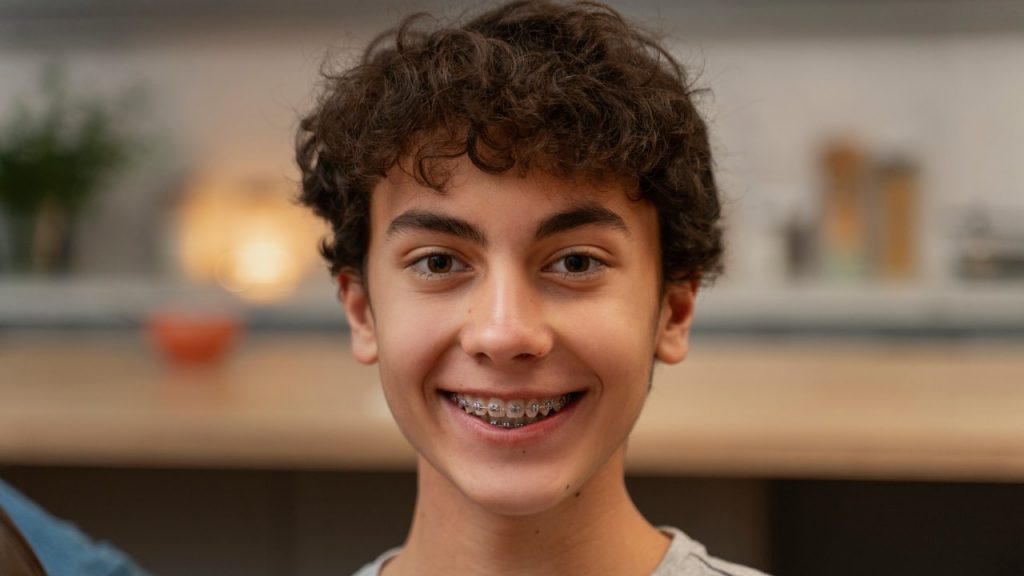Your orthodontic choice isn’t just based on looks, it’s also about fitting your lifestyle and achieving your goals. Traditional braces have long been the standard for correcting complex dental issues, while Invisalign provides a discreet and flexible alternative for many patients.
This article provides honest and expert advice from Anaheim Hills dentists who have guided numerous patients through this decision. By examining their advantages and limitations, you can make an informed decision that supports your long-term oral health and aesthetic goals.
Understanding the Basics
What are traditional braces?
Traditional braces are a well-established orthodontic treatment used to correct misaligned teeth and bite issues. They consist of brackets that are bonded to the teeth and connected by wires and small elastic bands. These components work together to gradually shift teeth into their desired positions over time.
There are several types of traditional braces, distinguished primarily by the materials used:
- Metal Braces: The most common type, made from high-grade stainless steel. These braces are highly durable and effective for treating a wide range of dental alignment problems.
- Ceramic Braces: Similar in design to metal braces but made of tooth-colored or clear ceramic materials, making them less noticeable. They offer a more aesthetic option for patients concerned about appearance.
- Lingual Braces: These braces are attached to the back (lingual side) of the teeth, making them invisible from the front. While highly discreet, they require specialized adjustment and may cause more initial discomfort.
What is Invisalign?
Invisalign is an advanced orthodontic system that uses a series of custom-made, clear plastic aligners to straighten teeth. Unlike traditional braces, Invisalign aligners are removable and nearly invisible, offering a discreet alternative.
The invisalign treatment begins with a detailed digital scan or impression of your teeth, which is used to design a personalized treatment plan. A series of aligners is then fabricated, each slightly different from the last, to progressively move the teeth into the desired alignment. Patients typically wear each set of aligners for about one to two weeks before switching to the next. Invisalign requires consistent wear, usually 20 to 22 hours per day, to be effective.
Key Differences Between Braces and Invisalign
When choosing between braces and Invisalign, comparing their differences across important factors will help you find the treatment that best fits your needs and lifestyle.
Appearance and Aesthetics
One of the most noticeable differences between braces and Invisalign is their appearance. Traditional braces, especially metal ones, are visible on the teeth, which may be a concern for those seeking a discreet treatment. Ceramic braces offer a less conspicuous alternative but are still noticeable.
Lingual braces are hidden behind the teeth, providing a fully concealed option but may require an adjustment period. Invisalign aligners, made of clear plastic, are virtually invisible when worn, making them popular among adults and teens who prefer a subtle look during treatment.
Treatment Duration and Effectiveness
The length of treatment varies based on the complexity of the dental issues. Traditional braces are often the preferred choice for severe misalignments or bite problems because they allow precise control over tooth movement. Treatment typically lasts between 18 and 36 months.
Invisalign is effective for mild to moderate orthodontic concerns and generally requires a similar treatment timeframe, often between 12 and 24 months. However, Invisalign’s success relies heavily on patient compliance, as the aligners must be worn consistently.
Comfort and Convenience
Braces involve brackets and wires that can cause discomfort, irritation, or soreness, particularly after adjustments. Some patients may experience difficulty speaking or eating initially. Invisalign aligners are made of smooth plastic, reducing irritation, and can be removed for eating, drinking, and cleaning, which adds convenience. However, the need to remove and replace aligners properly requires discipline and care.
Maintenance and Oral Hygiene
Maintaining oral hygiene is more challenging with traditional braces due to the brackets and wires, which can trap food particles and increase the risk of plaque buildup and tooth decay.
Patients must use special tools like interdental brushes or water flossers as recommended by dentists. Invisalign aligners can be removed for brushing and flossing, allowing for easier and more effective oral care throughout treatment.
Dietary Restrictions
Patients with braces must avoid certain foods that can damage the brackets or wires, such as sticky candies, hard nuts, and chewy snacks. These restrictions can impact daily eating habits. Invisalign users face no dietary restrictions since the aligners are removed during meals, allowing patients to eat and drink freely.
Cost Comparison
The cost of orthodontic treatment depends on several factors, including the severity of dental issues and treatment duration. Generally, Invisalign treatment may be slightly more expensive than traditional braces due to the technology and customization involved.
However, prices vary by provider and location. Understanding invisalign costs without insurance can help you plan your budget. It is important to discuss costs and payment options with your dental professional to determine the best fit for your budget.
Who Is a Good Candidate for Braces?

Traditional braces remain a reliable and effective orthodontic solution, particularly suited for certain patient profiles and dental conditions.
Complex Dental Issues (Severe Misalignment, Bite Correction)
Braces are often the preferred treatment for patients with significant dental challenges, including severe crowding, large gaps, rotated teeth, or complex bite problems such as overbite, underbite, or crossbite. Their design allows precise control over tooth movement, making them ideal for correcting complicated orthodontic cases.
Compliance Considerations (Patients Less Likely to Wear Removable Devices)
Since braces are fixed to the teeth, they do not rely on patient compliance to be effective. Patients who may struggle with consistently wearing removable appliances, like Invisalign aligners, often benefit more from braces. This fixed approach ensures continuous treatment without interruptions.
Age Factors
Braces can be suitable for a wide range of ages, including children, teens, and adults. For younger patients, especially those still growing, braces provide a stable option for guiding proper dental development. Adult patients with complex dental needs also frequently achieve successful outcomes with braces.
Who Is a Good Candidate for Invisalign?
Invisalign is an effective orthodontic option for many patients, but it is best suited for those who meet certain criteria.
Mild to Moderate Dental Corrections
Invisalign works well for patients with mild to moderate teeth misalignments, such as minor crowding, gaps, or slight bite issues. Complex cases involving severe misalignment or major bite corrections may require traditional braces or other orthodontic treatments for optimal results.
Preference for Discreet Treatment
Patients who prioritize a nearly invisible treatment option often choose Invisalign. The clear and removable aligners allow users to straighten their teeth without the noticeable appearance of metal braces, making it especially popular among adults and professionals.
Ability to Commit to Wearing Aligners 20–22 Hours per Day
Successful Invisalign treatment depends on consistent wear. Candidates must be disciplined enough to wear their aligners for 20 to 22 hours daily, removing them only for eating, drinking (except water), and oral hygiene. Failure to maintain this schedule can prolong treatment and reduce effectiveness.
Lifestyle and Personal Habits
Individuals with active lifestyles who require flexibility during meals or important events often benefit from Invisalign’s removable design. However, patients must also be responsible with aligner care, avoiding loss or damage. Those who frequently misplace items or have difficulty following routine instructions may find braces a more reliable option.
Common Misconceptions Addressed by Anaheim Hills Dentists
Orthodontic treatments like braces and Invisalign often come with misunderstandings that can influence patient decisions. Experienced dentists clarify some common misconceptions to help patients make informed choices.
Invisalign Is Only for Adults
Many believe Invisalign is exclusively for adults, but it is increasingly used by teenagers and even some younger patients. With specialized aligners designed for younger wearers, Invisalign can effectively address a variety of orthodontic concerns across age groups, provided the patient meets the necessary compliance requirements.
Braces Are Always More Effective
While braces are highly effective, especially for complex cases, Invisalign has advanced significantly and can address many orthodontic issues with comparable success. Effectiveness depends more on the specific dental condition and patient commitment rather than the type of appliance alone.
Invisalign Treatment Takes Longer
There is a perception that Invisalign extends treatment time compared to braces. However, treatment duration is largely determined by the severity of the dental correction needed and patient compliance. When worn as directed, Invisalign can offer treatment times similar to braces for many cases.
Cost Myths
Cost concerns often deter patients from choosing Invisalign, under the assumption that it is prohibitively expensive. While Invisalign can be slightly more costly due to its technology and customization, the difference is not always significant. Many dental practices offer flexible payment plans and financing options to accommodate various budgets.
Conclusion
Choosing between braces and Invisalign involves weighing various factors, including the complexity of your dental needs, lifestyle, and personal preferences. Both treatment options offer effective solutions for achieving a healthy and aligned smile when guided by experienced dental professionals.
Consulting with your orthodontist will help identify the best approach tailored to your unique situation. Taking this informed step will bring you closer to the confident smile you deserve.
Ready to take the next step? Book an appointment at MySmile Dental Care to receive personalized advice and start your journey toward a healthier and more beautiful smile.








